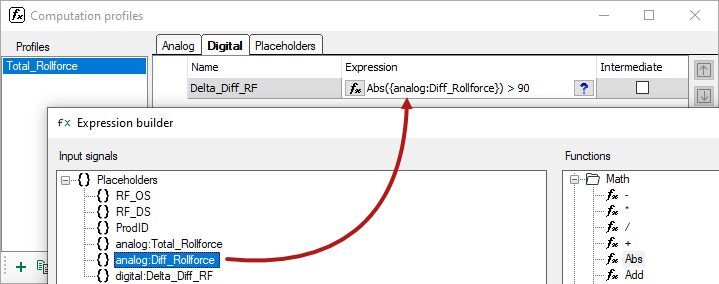In the Analog and Digital tabs you can now formulate the desired calculations.
As with the "Virtual" module, all the functions in the expression builder are available when you click the <fx> button in the Expression column.
In the formulas you can use the placeholders as well as the results of other expressions in the same profile, or constant values.
If you want to use the result of one line in another expression, use the predefined placeholders {analog:X} or {digital:Y}, where X and Y stand for the name of the expression in the Analog or Digital tab of the same profile.
If you populate several lines, you can manipulate the lines with the buttons on the right margin. The order of the lines is not relevant for the calculation of the expressions.
|
|
Move selected rows up |
|
|
Move selected rows down |
|
|
Delete selected rows |
|
|
Copy all rows |
|
|
Paste from clipboard, starting from the selected row |
In the Intermediate column, you have the option to classify each expression as an internal intermediate value. These expressions or signals are then not displayed in the signal table and are not available to be displayed in the ibaPDA client.
Example
Analog
Calculation of the total rolling force as the sum of the rolling force on the operating side and the rolling force on the drive side. Calculation of the differential rolling force as the difference between the two rolling forces.

In the expression builder, only the defined placeholders and placeholders for the internal calculation results are available for the calculation. I/O signals cannot be used here.

Digital
A digital signal should indicate when the absolute value of the differential rolling force exceeds a certain level (90 t).
In the following figure an internal calculation result is used for another expression.

The limit value of 90 t is permanently entered here. If this value were variable or process-dependent, then a placeholder would also have to be defined for it, which would then be linked to a corresponding signal.